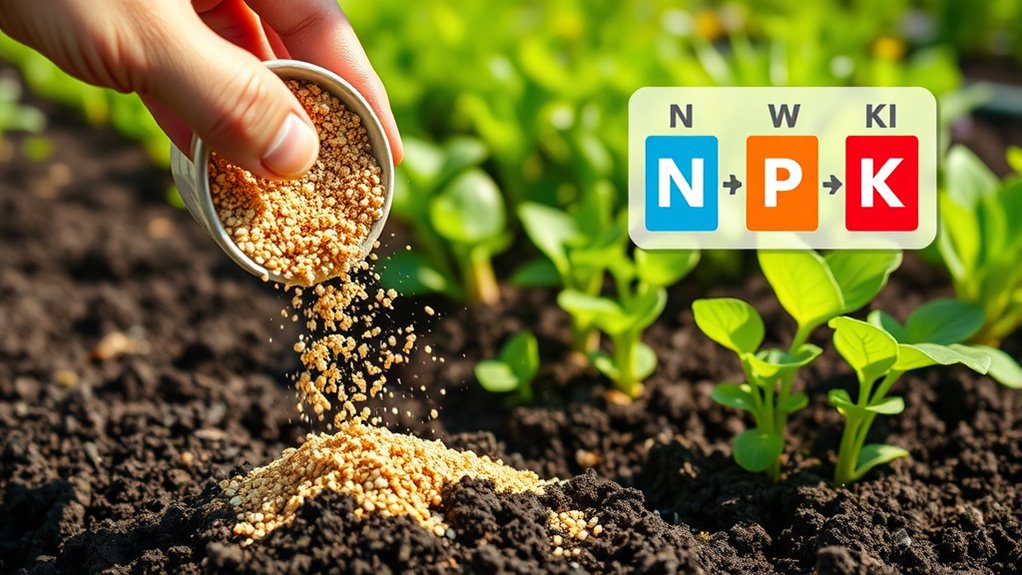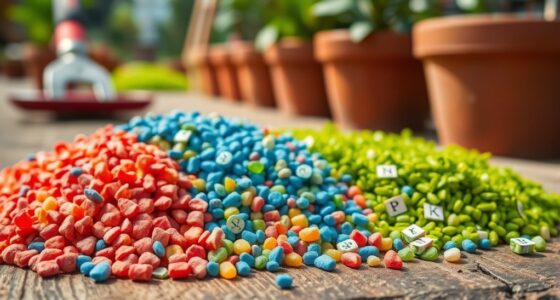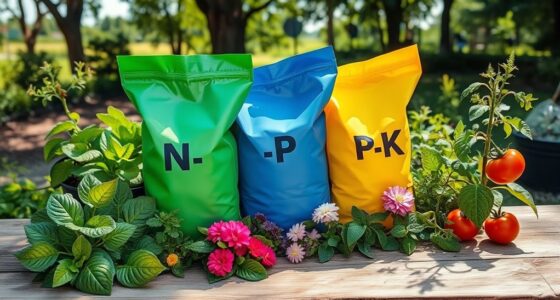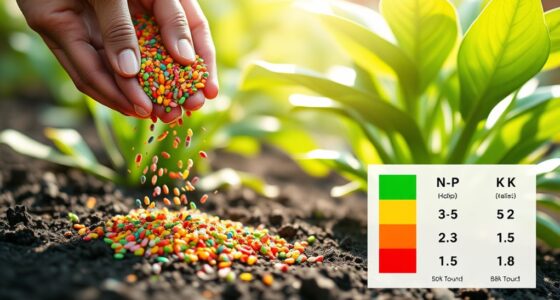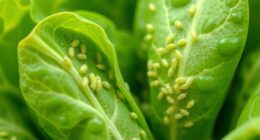Fertilizer 101 starts with understanding N-P-K ratios, which show the percentage of nitrogen, phosphorus, and potassium in a fertilizer. Nitrogen promotes green, leafy growth, phosphorus supports roots and flowers, while potassium boosts overall plant health. Knowing your soil’s needs helps you select the right balance for your plants’ stage and conditions. Applying the correct fertilizer correctly can make all the difference. Keep exploring to learn how to choose and use fertilizers effectively for a thriving garden.
Key Takeaways
- N-P-K ratios indicate the percentage of Nitrogen, Phosphorus, and Potassium in fertilizer, guiding plant nutrient needs.
- Nitrogen promotes lush, leafy growth; Phosphorus supports root development and flowering; Potassium enhances overall plant health.
- Match fertilizer N-P-K ratios to plant growth stages for optimal development and yield.
- Soil testing helps determine existing nutrient levels to select appropriate fertilizer ratios.
- Using the correct N-P-K balance prevents over-fertilization and promotes sustainable gardening.
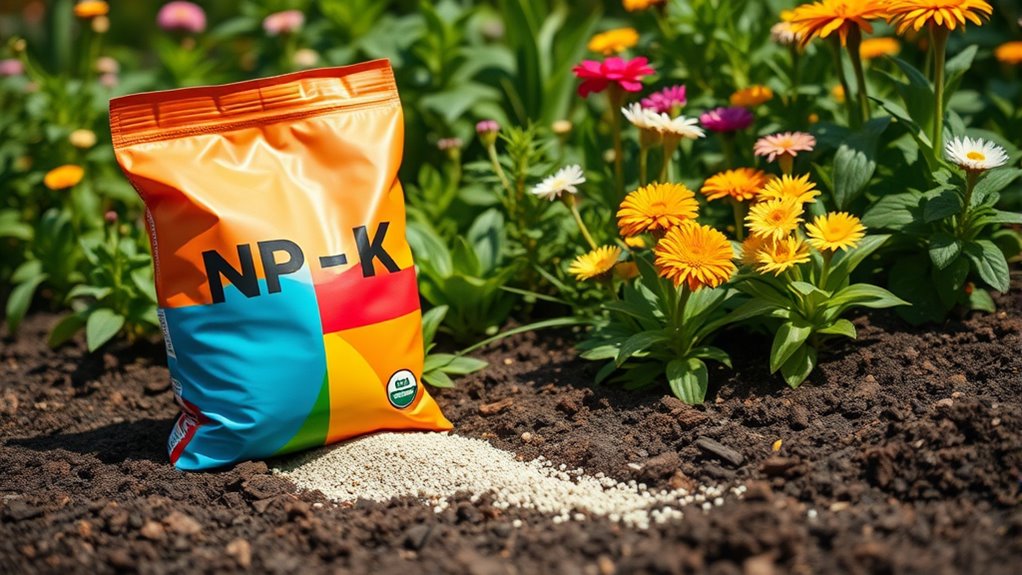
Ever wondered how to give your plants the nutrients they need to thrive? The secret starts with understanding what’s happening beneath the surface. Soil testing is your first step. Instead of guessing, you can determine exactly what nutrients your soil lacks or has in excess. Many local garden centers or extension services offer affordable soil testing kits or professional analysis. Once you have your results, you’ll know whether your soil needs more nitrogen, phosphorus, or potassium—key elements in plant growth. This knowledge helps you choose the right fertilizer and avoid over- or under-fertilizing. Organic options are an excellent way to improve soil health naturally. Compost, manure, bone meal, and fish emulsion boost nutrient levels without synthetic chemicals, making your garden more sustainable. Organic fertilizers also improve soil structure and microbial activity, which ultimately benefits your plants in the long run. Incorporating aesthetic wall organization ideas can further enhance your gardening space and create a more inviting environment.
Understanding N-P-K is essential. These three numbers on fertilizer packaging indicate the percentage of nitrogen (N), phosphorus (P), and potassium (K). Each element plays a specific role: nitrogen promotes lush, green growth; phosphorus supports root development and flowering; potassium helps with overall plant health and disease resistance. Depending on your plant’s stage and the soil test results, you may need to adjust these ratios. For example, leafy greens require high nitrogen, while flowering plants benefit from more phosphorus. Using the right balance ensures your plants get what they need without wasting resources or harming the environment.
Knowing when and how to apply fertilizer is just as important as knowing what to use. Always start by testing your soil, then select an organic option suited to your plants’ needs. Apply fertilizers according to the instructions, and avoid overdoing it—more isn’t always better. Organic options like composted manure release nutrients slowly, reducing the risk of over-fertilization and runoff. If you’re using liquid organic fertilizers, apply them during active growth periods for quick absorption. Remember, healthy soil leads to healthy plants, and soil testing guides you to make the most informed decisions.
Frequently Asked Questions
How Often Should I Fertilize My Plants?
You should fertilize your plants based on their specific needs, which can be determined through soil testing. Typically, you’ll want to fertilize every 4-6 weeks during active growing seasons. Proper fertilizer timing guarantees your plants get the nutrients they need without overdoing it. Keep an eye on plant health and soil conditions, adjusting your schedule as needed to promote healthy growth and avoid nutrient deficiencies.
Can I Use Synthetic Fertilizers on Organic Gardens?
You can use synthetic fertilizers in organic gardens, but it’s important to consider synthetic vs organic options and fertilizer safety. Synthetic fertilizers often provide quick nutrients, but some may not align with organic standards and could impact soil health. To maintain an organic approach, opt for certified organic fertilizers. Always read labels carefully to ensure the fertilizer’s safety and compatibility with organic gardening principles, supporting healthy, sustainable plant growth.
What Are the Signs of Over-Fertilizing?
Think of your garden as a delicate balance scale; over-fertilizing tips it into chaos. Signs of nutrient toxicity and plant stress include yellowing leaves, brown tips, stunted growth, or wilting. You might notice patches of dead or discolored foliage, indicating too much fertilizer. If you see these, reduce feeding immediately. Recognize these signals as your plants begging for harmony, reminding you that more isn’t always better in nurturing healthy growth.
Are There Environmentally Friendly Fertilizer Options?
You’re wondering if there are environmentally friendly fertilizer options. Yes, you can use compost teas and organic amendments, which nourish your plants naturally without harming the environment. These options improve soil health, boost plant growth, and reduce chemical runoff. By choosing compost teas and organic amendments, you support sustainable gardening and help protect ecosystems, making your gardening practices more eco-friendly and safe for both your plants and the planet.
How Do I Choose the Right Fertilizer for My Specific Plants?
To choose the right fertilizer for your plants, you should start with soil testing to identify nutrient deficiencies. Use this information to select plant-specific formulas that meet your plants’ needs. Consider organic options if you want an environmentally friendly approach. By matching fertilizers to your soil’s condition and your plants’ requirements, you’ll promote healthy growth and avoid over-fertilizing or harming the environment.
Conclusion
Now that you understand the dance of N-P-K, you hold the keys to reveal your plants’ fullest potential. Think of fertilizers as the symphony’s conductor, guiding each note to create a lush, vibrant masterpiece. With this knowledge, you’re no longer just a caretaker but a gardener of dreams. So go ahead—nurture your green friends with confidence, and watch your garden flourish like a beautiful, unstoppable story of growth and life.
